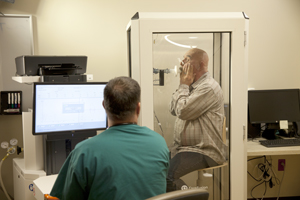Pulmonary Function Tests
Pulmonary Function Tests
Pulmonary function tests (also called lung function tests) help measure how well your lungs are working. The tests measure the amount of air you breathe out (exhale) and how long it takes for you to exhale completely. These tests are done to diagnose lung conditions such as asthma and COPD (chronic obstructive pulmonary disease). They may be done before and after you take certain medicines. They may also be used to find out if your shortness of breath gets worse with exercise. Over time, pulmonary function tests can help you and your healthcare providers see how well your treatment is working.
Your experience
A complete pulmonary function test has 3 parts. You may be given the entire test or only certain parts. The entire test is painless and can last 45 to 90 minutes. If you get tired, you can take a break between test sections.
Before your test
Follow any instructions you are given to prepare for the test. Otherwise, your test may be canceled.
Stop smoking for at least 1 hour before the test, or as directed.
Don't drink alcohol for at least 4 hours before the test.
Ask your healthcare provider if you should stop taking your breathing medicine 4 to 24 hours before the test.
Don't have caffeine and eat only a light meal. Also limit the amount of fluids you drink.
Wear loose clothes that don’t restrict your breathing.
Tell the healthcare provider if you have any of these symptoms during the test:
Sore mouth
Chest, arm, or jaw pain
Tiredness (fatigue) or dizziness
Severe shortness of breath
During your test
The healthcare provider will coach you during your test. Depending on how many parts of the test you have, you may sit in a chair and breathe through a mouthpiece. Or you may sit in a clear plastic box that looks like a phone booth. You will wear nose clips so you only breathe through your mouth.
During spirometry, you hold your breath and blow it out fast. Spirometry is repeated at least 3 times to measure your best effort.
During diffusion, you hold your breath for 10 seconds. The test measures how well your lungs move air into your blood.
During lung volume, you breathe in different mixtures of air. How much air you inhale and exhale is measured. The amount of air that stays in your lungs is also measured.
After your test
After the test, you can return to your normal diet, activity, and medicines. If you were asked to skip medicines before the test, ask if you should take them now. Your healthcare provider will discuss the test results with you at your next visit.
Words you may hear
Pulmonary function tests measure how much air you can exhale, and how quickly. There are several types of pulmonary function graphs that show data from the tests. Some of the things that tests measure include:
FVC (forced vital capacity). This is the total amount of air you can exhale in a single, prolonged breath.
FEV1 (forced expiratory volume in one second). This is the amount of air you exhale in the first second. FEV1 is often expressed as a percentage of FVC.
FEV1/FVC. This is the amount of air exhaled in the first second compared with the total amount of air exhaled. It’s given as a fraction (ratio) or a percentage. In general, the higher the FEV1/FVC, the better.
PEF (peak expiratory flow). This is a measure of how fast you can exhale. It can be tested with spirometry or a peak flow meter.
Updated:
June 17, 2017
Sources:
Overview of Pulmonary Function Testing in Adults. UpToDate., Pulmonary Function Tests. American Thoracic Society.
Reviewed By:
Blaivas, Allen J., DO,Image reviewed by StayWell medical illustration team.,Sather, Rita, RN
